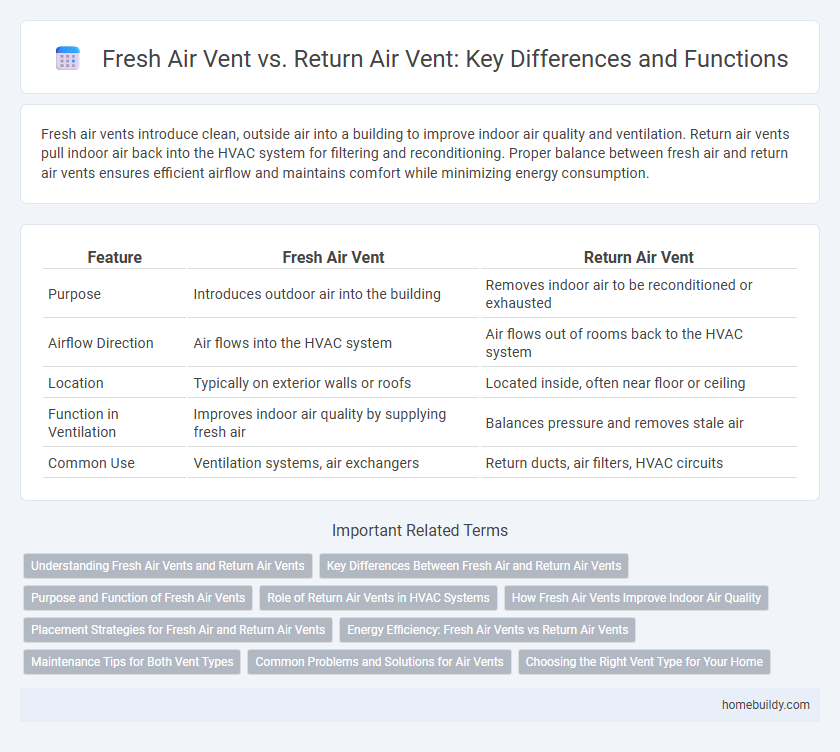Fresh air vents introduce clean, outside air into a building to improve indoor air quality and ventilation. Return air vents pull indoor air back into the HVAC system for filtering and reconditioning. Proper balance between fresh air and return air vents ensures efficient airflow and maintains comfort while minimizing energy consumption.
Table of Comparison
| Feature | Fresh Air Vent | Return Air Vent |
|---|---|---|
| Purpose | Introduces outdoor air into the building | Removes indoor air to be reconditioned or exhausted |
| Airflow Direction | Air flows into the HVAC system | Air flows out of rooms back to the HVAC system |
| Location | Typically on exterior walls or roofs | Located inside, often near floor or ceiling |
| Function in Ventilation | Improves indoor air quality by supplying fresh air | Balances pressure and removes stale air |
| Common Use | Ventilation systems, air exchangers | Return ducts, air filters, HVAC circuits |
Understanding Fresh Air Vents and Return Air Vents
Fresh air vents introduce outside air into a building, improving indoor air quality by reducing pollutants and controlling humidity levels. Return air vents pull stale air from the interior back into the HVAC system for filtering and reconditioning, maintaining consistent airflow and temperature. Proper balance between fresh air vents and return air vents ensures efficient ventilation and energy performance in residential or commercial spaces.
Key Differences Between Fresh Air and Return Air Vents
Fresh air vents supply outdoor air directly into indoor spaces, improving ventilation and air quality by introducing oxygen-rich air. Return air vents pull indoor air back into the HVAC system for filtering and reconditioning, maintaining consistent temperature and reducing contaminants. The key difference lies in their function: fresh air vents bring new air in, while return air vents circulate existing indoor air.
Purpose and Function of Fresh Air Vents
Fresh air vents introduce outdoor air into a building, enhancing indoor air quality by diluting pollutants and controlling humidity levels. They serve the crucial function of ventilating the space with clean, oxygen-rich air, which supports occupant health and comfort. Unlike return air vents that recirculate indoor air back to the HVAC system, fresh air vents are designed to maintain proper airflow balance and reduce indoor contaminants.
Role of Return Air Vents in HVAC Systems
Return air vents play a crucial role in HVAC systems by drawing used air from indoor spaces back into the system for reconditioning, improving energy efficiency and maintaining consistent temperature control. Unlike fresh air vents that introduce outside air, return air vents help circulate and filter indoor air, promoting better air quality and reducing strain on heating and cooling units. Properly designed and maintained return air vents prevent pressure imbalances and enhance overall HVAC system performance.
How Fresh Air Vents Improve Indoor Air Quality
Fresh air vents introduce outdoor air into indoor spaces, which significantly enhances indoor air quality by diluting pollutants and reducing the concentration of carbon dioxide. Unlike return air vents that recirculate indoor air, fresh air vents ensure a continuous supply of oxygen-rich air, preventing the buildup of allergens, volatile organic compounds (VOCs), and moisture. This airflow exchange promotes healthier breathing environments and minimizes risks related to indoor air contaminants.
Placement Strategies for Fresh Air and Return Air Vents
Fresh air vents are strategically placed near windows or exterior walls to introduce outdoor air into living spaces, ensuring optimal ventilation and air quality. Return air vents are commonly located in central areas, often on interior walls or ceilings, facilitating efficient airflow by drawing air back into the HVAC system for filtration and recirculation. Proper placement of fresh air and return air vents enhances energy efficiency and maintains balanced indoor air pressure for consistent climate control.
Energy Efficiency: Fresh Air Vents vs Return Air Vents
Fresh air vents introduce outside air into a building, increasing ventilation but potentially raising energy consumption due to heating or cooling the incoming air. Return air vents recirculate indoor air back to the HVAC system, promoting energy efficiency by reducing the load on heating and cooling units. Balancing fresh air intake with return air flow optimizes indoor air quality while minimizing energy costs.
Maintenance Tips for Both Vent Types
Regular cleaning of fresh air vents prevents blockages caused by dust and outdoor debris, enhancing indoor air quality and ventilation efficiency. Return air vents require frequent filter replacements to avoid dust buildup that can restrict airflow and strain HVAC systems. Inspecting both vent types for leaks and ensuring seals are intact prolongs system lifespan and maintains optimal energy performance.
Common Problems and Solutions for Air Vents
Fresh air vents often face issues with clogging from dust and debris, reducing indoor air quality and ventilation efficiency; regular cleaning and installing high-quality filters can mitigate these problems. Return air vents commonly experience blockages due to furniture placement or accumulation of dirt, leading to poor air circulation and increased energy consumption; rearranging room layouts and scheduling routine maintenance help maintain optimal airflow. Both types of vents benefit from professional inspections to detect leaks or damage that compromise HVAC system performance and indoor comfort.
Choosing the Right Vent Type for Your Home
Fresh air vents introduce outdoor air into your home, improving indoor air quality by reducing pollutants and humidity. Return air vents draw stale air from rooms back to the HVAC system for filtering and temperature control, maintaining efficient airflow. Selecting the appropriate vent type depends on your home's ventilation needs, climate, and HVAC design to ensure optimal comfort and energy efficiency.
Fresh air vent vs Return air vent Infographic

 homebuildy.com
homebuildy.com